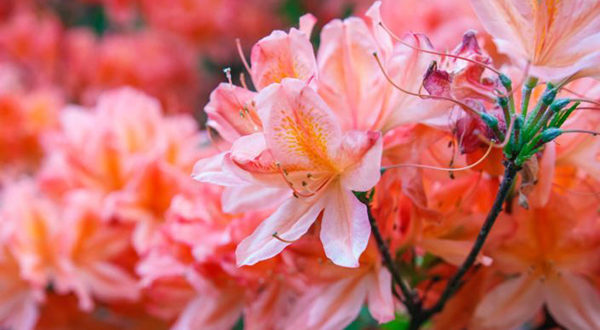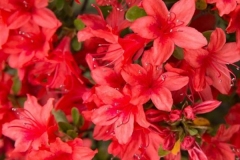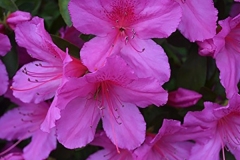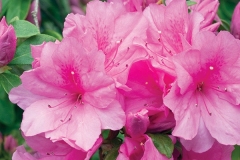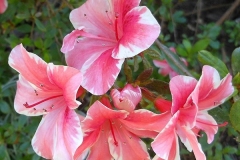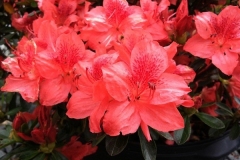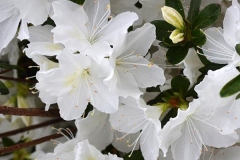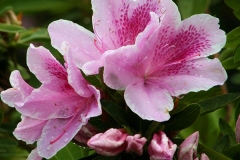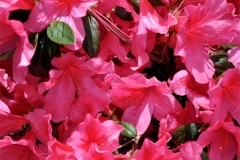Common Name: Azalea
Scientific Name: Rhododendron spp.
Type of Plant: Shrub
Description: Azaleas are a classic Southern plant, both for the structure they provide year-round and for the magnificent floral displays they produce. Few other flowering shrubs put on such a spectacular show—some azaleas produce so many flowers at once that you can hardly see the leaves!
Mature Size: 2-3′ tall x 2-3′ wide (Dwarf varieties), 4-8′ tall x 4-8′ wide (Standard varieties)
Blooms: Spring
Fruit: No
Climate Requirements: Azaleas perform best in areas with filtered sunlight. Their shallow root system and low tolerance to drought and poor soil drainage make placement and care important. Dappled or partial shade provides conditions for healthy growth and optimum flowering. Most do best when protected from intense afternoon sun. On the other hand, dense shade reduces plant growth and flowering. Azaleas exposed directly to early morning sun after a hard freeze thaw too rapidly, which causes bark splitting. Death of branches with split bark may not occur until months after the injury. Well-drained, acidic soils with pH 4.5–6.0 are best suited for azaleas because they prefer the ample quantities of iron and other micronutrients that are readily available in acidic soils.
Care Requirements: Azaleas are widely planted in Florida because of the colorful flowers they produce from late February to early April. Pruning your azaleas can improve their blooming and help them develop into full, well-branched shrubs. Always prune your plants in late spring or early summer, shortly after flowering, because azaleas set their flower buds for next year during the summer. Prune too late and chances increase that you will remove flower buds. Several light prunings early in the growing season will help your azalea develop the nicest form. Remove shaded-out branches first, since these often become dead wood. Older plants may have tall leggy branches that need to be removed. Doing so gradually over several years reduces shock to the plant. Frequent and light fertilizer applications are often necessary in Florida’s sandy soils. An acid-forming fertilizer containing iron and other micronutrients (sometimes sold as an “Azalea Special Fertilizer”) should be applied as needed. Micronutrients should be applied with foliar sprays or soil-applied products when deficiencies occur.
Spacing: Space plants 36-60″ apart
Water Needs: Irrigation is necessary for successful establishment and optimum growth during extended dry periods. Generally, established plants should receive about ¾–1 inch of water every 10 days to 2 weeks during dry periods to wet the soil to a depth of 10–12 inches. The lower leaves of plants that undergo a severe wilt will yellow and drop.
Maintenance: Average
Special Uses/Attributes: Because evergreen azaleas hold their leaves year-round, they make great backdrop plants for seasonal flower beds. And of course in the spring, they put on their own show with flowers ranging in color from white, to pink, to red, depending on the cultivar.
Florida Native: No

